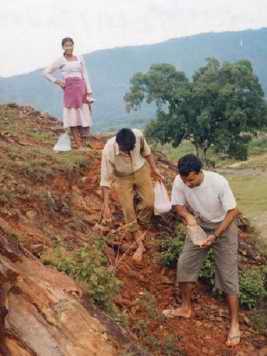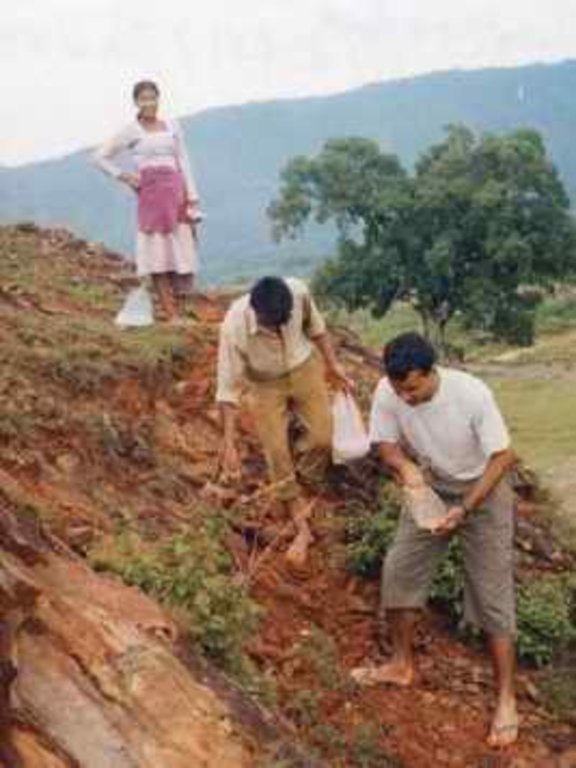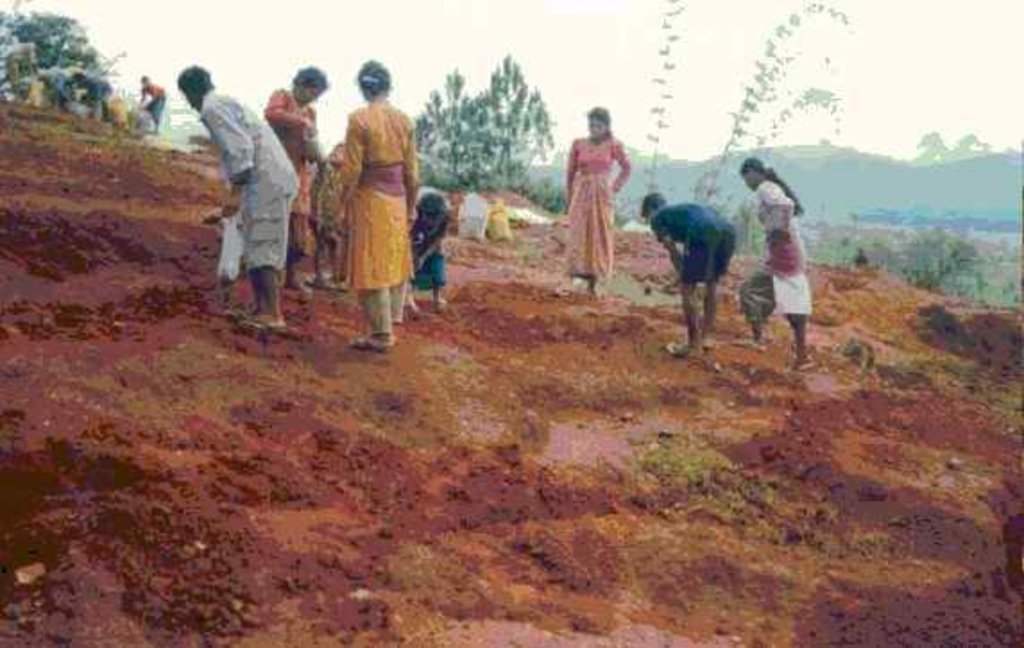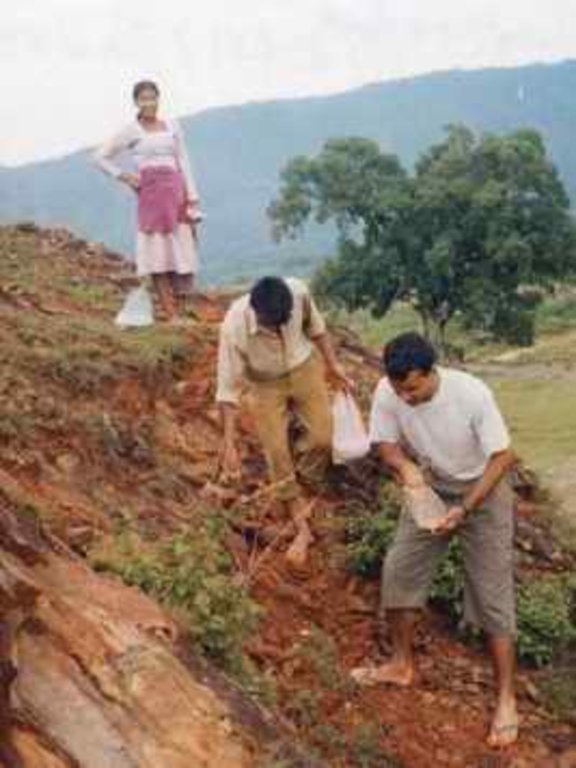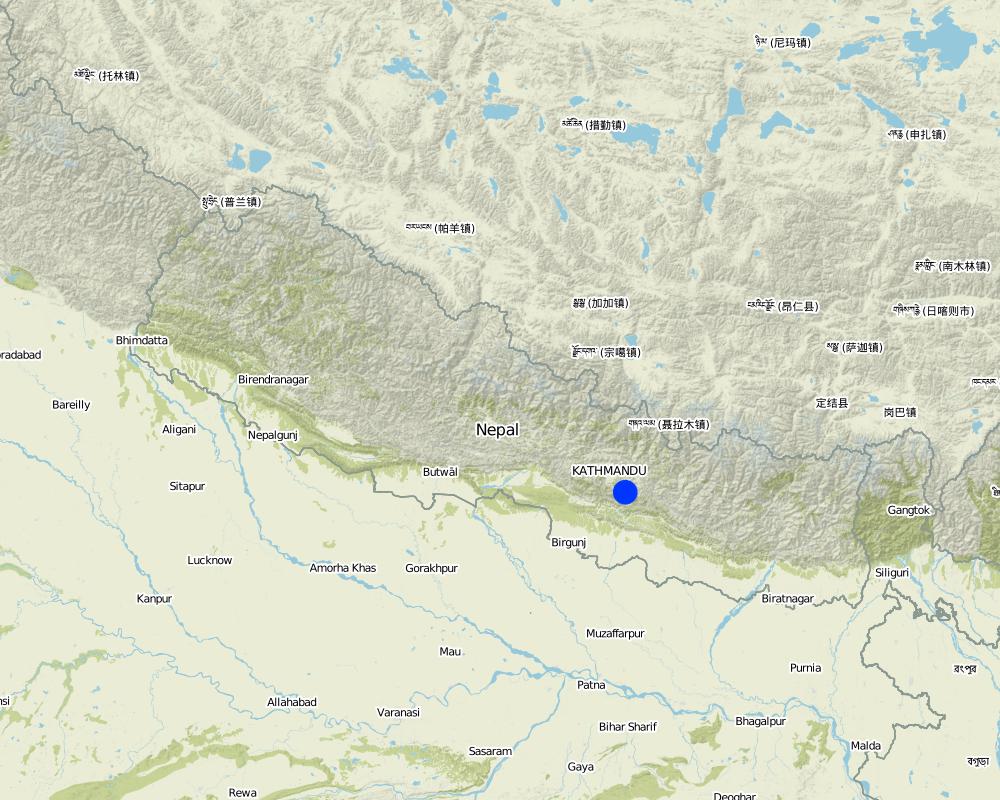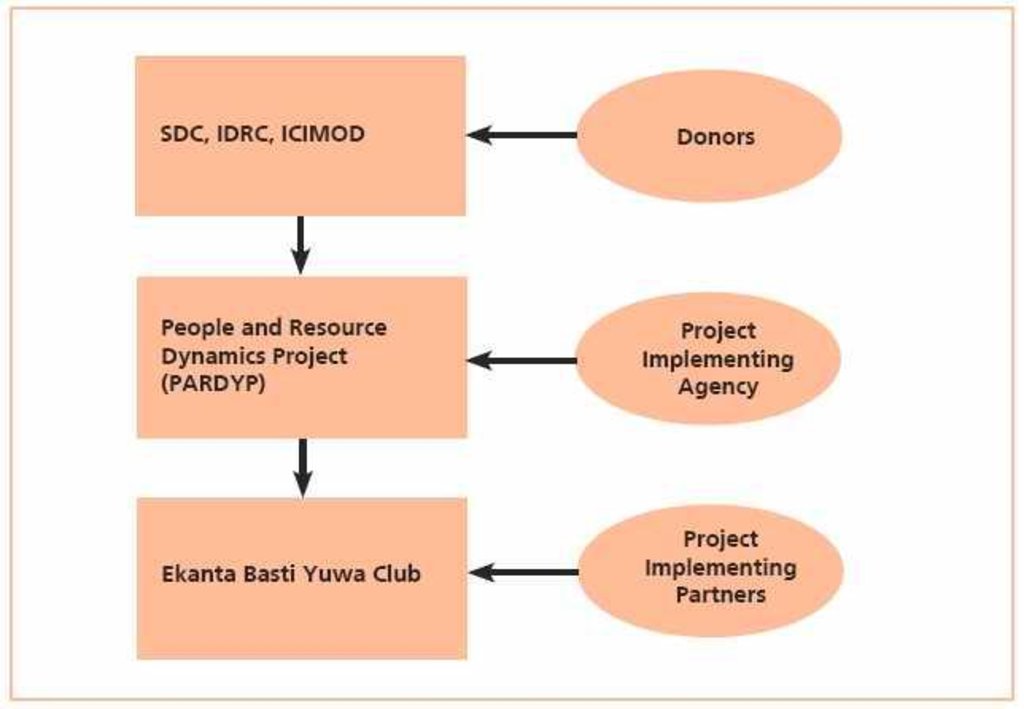Local initiatives for rehabilitating degraded communal grazing land [Népal]
- Création :
- Mise à jour :
- Compilateur : Madhav Dhakal
- Rédacteur : –
- Examinateur : Fabian Ottiger
Kshetigrasta samudayik charan bhumi punarutthan ma sthaniya agrasarata (Nepali)
approaches_2353 - Népal
Voir les sections
Développer tout Réduire tout1. Informations générales
1.2 Coordonnées des personnes-ressources et des institutions impliquées dans l'évaluation et la documentation de l'Approche
Spécialiste GDT:
Nom du ou des institutions qui ont facilité la documentation/ l'évaluation de l'Approche (si pertinent)
CDE Centre for Development and Environment (CDE Centre for Development and Environment) - SuisseNom du ou des institutions qui ont facilité la documentation/ l'évaluation de l'Approche (si pertinent)
ICIMOD International Centre for Integrated Mountain Development (ICIMOD) - Népal1.3 Conditions relatives à l'utilisation par WOCAT des données documentées
Le compilateur et la(les) personne(s) ressource(s) acceptent les conditions relatives à l'utilisation par WOCAT des données documentées:
Oui
1.4 Références au(x) questionnaire(s) sur les Technologies de GDT
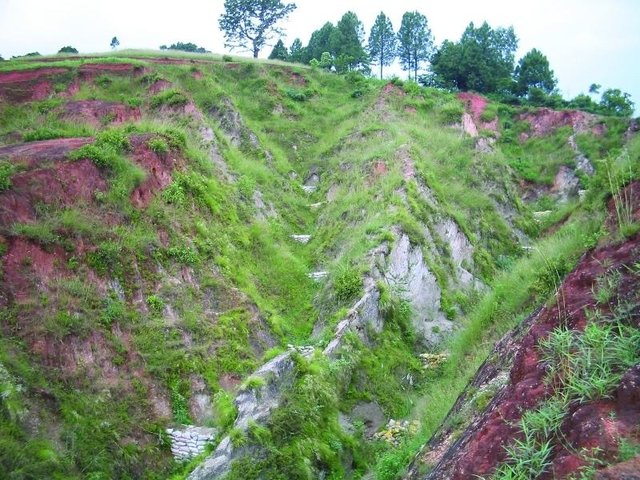
Gully plugging using check dams [Népal]
Small dam structures constructed across erosion gullies
- Compilateur : Nicole Guedel
2. Description de l'Approche de GDT
2.1 Courte description de l'Approche
Supporting local initiatives and building local capacity for the rehabilitation of degraded communal land in the middle mountains of Nepal.
2.2 Description détaillée de l'Approche
Description détaillée de l'Approche:
Aims / objectives: The main aim of the People and Resource Dynamics Project's (PARDYP) land rehabilitation activities were to help watershed residents, local groups, and line agencies understand the key issues and to test options for the improved management of water, land, and forests in a participatory way. In Dhotra VDC (Kavrepalanchok district) a local youth club (Ekantabasti Youth Club) had been trying to rehabilitate a 2.5 ha area of degraded communal land since May 2004. The club approached PARDYP for technical assistance. The area had been degraded by overgrazing with two big gullies formed and small landslips along the gullies affecting a trail and the adjoining agricultural land. An unsuccessful attempt had been made to plant the area eight years previously. It had failed due to the difficulty of retaining soil moisture in the area's compacted red soils. A series of meetings were organised to plan future activities, to ensure community participation, and to share responsibilities among local users and PARDYP. The community was committed to rehabilitating the area and took the responsibility for planting, protection, and overall management of the planted species. PARDYP provided planting materials and technical help. A needs assessment with the local people identified the most useful tree species. They entrusted the selection of appropriate grass and hedgerow species to the project's expertise. Project staff arrange for planting materials and logistical support, and showed villagers how to make eyebrow pits, plant hedgerows, and plug gullies. About 450 villagers participated in the rehabilitation activities with women contributing more than half of the labour. They worked four hours a day for 16 mornings.
Methods: A five-women strong user committee was formed to manage and protect the planted species and a five-man strong task force was set up to maintain regular links and coordination between the user committee, the youth club, and the villagers. The coordination committee, with guidance from the youth club, was responsible for facilitating and coordinating all the second season rehabilitation work in 2005.
2.3 Photos de l'approche
2.5 Pays/ région/ lieux où l'Approche a été appliquée
Pays:
Népal
Autres spécifications du lieu :
Kavrepalanchowk/ Jhikhu khola watershed
Map
×2.6 Dates de début et de fin de l'Approche
Date (année) de fin de l'Approche (si l'Approche n'est plus appliquée):
2005
2.7 Type d'Approche
- fondé sur un projet/ programme
2.8 Principaux objectifs de l'Approche
The Approach focused on SLM only
- To demonstrate appropriate technologies for rehabilitating degraded land and evaluating their effectiveness. - To provide training on soil and water conservation (SWC) technologies for effectively implementing the rehabilitation activities and to build the capacity of the local community to carry out the work. - To organise and mobilise a local community for implementing, protecting and managing the planted areas and the physical structures
The SLM Approach addressed the following problems: - Lack of awareness about low cost soil and water conservation technologies that address farmers' needs. - Weak institutional collaboration for developing and implementing technologies
2.9 Conditions favorisant ou entravant la mise en œuvre de la(des) Technologie(s) appliquée(s) sous l'Approche
disponibilité/ accès aux ressources et services financiers
- entrave
Government incentives lacking
Treatment through the SLM Approach: Cost-effective technology demonstrated; planting materials and other logistic support provided
cadre institutionnel
- entrave
Weak institutional collaboration for technology development and demonstration
Treatment through the SLM Approach: Collaboration with local youth club; formation of user committee and task force
cadre juridique (régime foncier, droits d'utilisation des terres et de l'eau)
- entrave
The existing land ownership, land use rights / water rights hindered a little the approach implementation The land is owned by the state and prior to starting the work there was a conflict over where the boundaries lay. Adjacent private landowners illegally claimed a part of the land but withdrew their claims before the rehabilitation work started. The existing land ownership and land use rights hindered the implementation of the approach at the beginning.
connaissances sur la GDT, accès aux supports techniques
- entrave
Limited knowledge of appropriate SWC technologies and limited technical know-how to implement them
Treatment through the SLM Approach: On-site training and exchange visits organised to demonstration sites
3. Participation et rôles des parties prenantes impliquées dans l'Approche
3.1 Parties prenantes impliquées dans l'Approche et rôles
- exploitants locaux des terres / communautés locales
Planning, implementing SLM activities and protection. Men and women worked equally. About 450 villagers participated in the rehabilitation activities. Women's participation was a little higher, they provided 56% of the labour.
- Spécialistes de la GDT/ conseillers agricoles
- ONG
Technical and logistics support
- gouvernement national (planificateurs, décideurs)
Si plusieurs parties prenantes sont impliquées, indiquez l'organisme chef de file ou l'institution responsable:
Initiation and implementation by local youth club representing land users. Technical and logistics support by national specialists
3.2 Participation des exploitants locaux des terres/ communautés locales aux différentes phases de l'Approche
| Participation des exploitants locaux des terres/ communautés locales | Spécifiez qui était impliqué et décrivez les activités | |
|---|---|---|
| initiation/ motivation | interactive | Local youth club approached PARDYP for technical help during a meeting. |
| planification | interactive | Public meetings organised to share responsibilities. Land users took responsibility for land preparation, planting, protection, grazing control, and overall management of planted species. Men and women performed planned activities together. Construction of eyebrow pits done mostly by men. Filling o |
| mise en œuvre | auto-mobilisation | Self-mobilised group under leadership of youth club implemented the activities; technical guidance during implementing period provided by project |
| suivi/ évaluation | interactive | Survival of planted species, effect of eyebrow pits, performance of species and check dams were monitored/observed. Results shared in public meetings and reported to the project |
| Research | aucun |
3.3 Diagramme/ organigramme (si disponible)
Description:
PARDP project donors and implementing partners: SDC: (Swiss Agency for Development and Cooperation); IDRC (Internat. Development Research Centre); ICIMOD
Auteur:
Dhakal Madhav
3.4 Prises de décision pour la sélection de la Technologie/ des Technologies
Indiquez qui a décidé de la sélection de la Technologie/ des Technologies à mettre en œuvre:
- principalement les spécialistes de la GDT, après consultation des exploitants des terres
Expliquez:
A local youth club (Ekantabasti youth club) has initiated rehabilitation activities on the degraded communal land since May 2004. The youth club approached PARDYP for the technical assistance.
Decisions on the method of implementing the SLM Technology were made by mainly by land users supported by SLM specialists. Villagers took the responsibility for planting, protecting, and overall management of the planted species. PARDYP arranged planting materials and technical support
4. Soutien technique, renforcement des capacités et gestion des connaissances
4.1 Renforcement des capacités/ formation
Une formation a-t-elle été dispensée aux exploitants des terres/ autres parties prenantes?
Oui
Spécifiez qui a été formé:
- exploitants des terres
Formats de la formation:
- zones de démonstration
Thèmes abordés:
On-site training sessions were organised for establishing the eyebrow pits, contour hedgerows, gully treatments, and check dams and their maintenance.
4.2 Service de conseils
Les exploitants des terres ont-ils accès à un service de conseils?
Oui
Spécifiez si le service de conseils est fourni:
- dans les champs des exploitants?
Décrivez/ commentez:
Name of method used for advisory service: Rehabilitation of degraded land thorough demonstration and training; Key elements: On site training, Demonstration, Exchange visits and public meetings; After implementing the technology, a number of exchange and interaction, audio visual presentation, and monitoring programmes were carried out as a scaling up strategy.
Advisory service is quite adequate to ensure the continuation of land conservation activities; Trained human resources can continue the activities.
4.3 Renforcement des institutions (développement organisationnel)
Des institutions ont elles été mises en place ou renforcées par le biais de l'Approche?
- oui, modérément
Spécifiez à quel(s) niveau(x), ces institutions ont été renforcées ou mises en place:
- local
Précisez le type de soutien:
- renforcement des capacités/ formation
Donnez plus de détails:
Technical training was provided to local youth club.
4.4 Suivi et évaluation
Le suivi et l'évaluation font ils partie de l'Approche? :
Oui
Commentaires:
bio-physical aspects were ad hoc monitored through observations; indicators: soil type and texture
technical aspects were regular monitored through measurements; indicators: performance of planted species and their survival rates
socio-cultural aspects were ad hoc monitored through observations; indicators: preferred tree species and closing the area for grazing
economic / production aspects were ad hoc monitored through observations; indicators: seed and grass production
no. of land users involved aspects were ad hoc monitored through observations; indicators: participation in maintaining planted species and structures
There were no changes in the Approach as a result of monitoring and evaluation: The users increased the size of the eyebrow pits and dug new pits and extended the hedgerow lines to fill in gaps; but the overall approach was not changed.
4.5 Recherche
La recherche a-t-elle fait partie intégrante de l’Approche?
Oui
Spécifiez les thèmes:
- technologie
Donnez plus de détails et indiquez qui a mené ces recherches:
Research was not a major focus of the approach although the performance and survival rates of planted species, and performance of eyebrow pits and connecting drainage trenches were regularly observed.
Research was carried out on-farm
5. Financement et soutien matériel externe
5.1 Budget annuel de la composante GDT de l'Approche
Si le budget annuel précis n'est pas connu, indiquez une fourchette:
- < 2 000
Commentez (par ex. principales sources de financement/ principaux bailleurs de fonds):
Approach costs were met by the following donors: international (SDC, IDRC, ICIMOD): 90.0%; local community / land user(s) (materials and tools for training): 10.0%
5.3 Subventions pour des intrants spécifiques (incluant la main d'œuvre)
- intrants agricoles
| Spécifiez les intrants subventionnés | Dans quelle mesure | Spécifiez les subventions |
|---|---|---|
| semences | From projects own seed bank | |
| Seedlings | en partie financé | Some locally arranged and some from forest departm |
Si la main d'œuvre fournie par les exploitants des terres était un intrant substantiel, elle était:
- volontaire
Commentaires:
Land users involvement was fully voluntary, they worked together in a cooperative spirit to improve their common degraded land.
5.4 Crédits
Des crédits ont-ils été alloués à travers l'Approche pour les activités de GDT?
Non
6. Analyses d'impact et conclusions
6.1 Impacts de l'Approche
Est-ce que l'Approche a aidé les exploitants des terres à mettre en œuvre et entretenir les Technologies de GDT?
- Non
- Oui, un peu
- Oui, modérément
- Oui, beaucoup
An organized land users' group was formed, and awareness on SLM increased.
Est-ce que l'Approche a amélioré les questions foncières et des droits d'utilisation qui entravent la mise en œuvre des Technologies?
- Non
- Oui, un peu
- Oui, modérément
- Oui, beaucoup
Project requested the users to solve the problem before rehabilitation work, users community and private land users solved the issue by measuring area of the community land. An authorized technician from the government office helped solving the issue.
Did other land users / projects adopt the Approach?
- Non
- Oui, un peu
- Oui, modérément
- Oui, beaucoup
The approach adopted during rehabilitation activities is quite standard and is taken by many other land management and community development projects.
6.2 Principale motivation des exploitants des terres pour mettre en œuvre la GDT
- conscience environnementale
reduction of soil erosion
- améliorer l'esthétique
to maintain greenery.
6.3 Durabilité des activités de l'Approche
Les exploitants des terres peuvent-ils poursuivre ce qui a été mis en œuvre par le biais de l'Approche (sans soutien extérieur)?
- incertain
Si non ou incertain, spécifiez et commentez:
Land users planned to upscale the technology and its related approach to rehabilitate the degraded areas of their community forest but it hasn't happened yet.
6.4 Points forts/ avantages de l'Approche
| Points forts/ avantages/ possibilités du point de vue de l'exploitant des terres |
|---|
| Suitable technologies were shared and valuable knowledge given during the rehabilitation work (How to sustain/ enhance this strength: Continue this incorporating new ideas) |
| Community institution strengthened, and some money (US$ 17) raised by selling grasses and grass seed within two years of rehabilitation. Money used for social activities (How to sustain/ enhance this strength: As above) |
| Points forts/ avantages/ possibilités du point de vue du compilateur ou d'une autre personne ressource clé |
|---|
| Site visits and focus group discussion meetings were effective for disseminating and scaling up the approach (How to sustain/ enhance this strength: Continue these initiatives on a regular basis to strengthen land users??? involvement in SLM activities) |
| Among total participants, women's participation was higher. User committee was made up of just women (How to sustain/ enhance this strength: Continue this) |
| The local youth club played a key role in rehabilitation activities - a key factor for sustainability and continuity (How to sustain/ enhance this strength: More local institutions should be identified and involved.) |
| This is a bottom-up approach with the rehabilitation activities purely demand driven. Farmers' priorities for tree species to be planted were identified in a participatory way (How to sustain/ enhance this strength: Continue by including new priorities) |
6.5 Faiblesses/ inconvénients de l'Approche et moyens de les surmonter
| Faiblesses/ inconvénients/ risques du point de vue de l’exploitant des terres | Comment peuvent-ils être surmontés? |
|---|---|
| Research was not a main focus of the activity, and not enough options were explored. | Explore and test more options |
| Faiblesses/ inconvénients/ risques du point de vue du compilateur ou d'une autre personne ressource clé | Comment peuvent-ils être surmontés? |
|---|---|
| Collaboration with government line agencies was lacking | Rehabilitation work should be carried out involving all main stakeholders |
7. Références et liens
7.1 Méthodes/ sources d'information
- visites de terrain, enquêtes sur le terrain
- interviews/entretiens avec les exploitants des terres
7.2 Références des publications disponibles
Titre, auteur, année, ISBN:
ICIMOD (2007) Good Practices in Watershed Management, Lessons Learned in the Mid Hills of Nepal. Kathmandu: ICIMOD
Disponible à partir d'où? Coût?
ICOMOD
Liens et modules
Développer tout Réduire toutLiens

Gully plugging using check dams [Népal]
Small dam structures constructed across erosion gullies
- Compilateur : Nicole Guedel
Modules
Aucun module trouvé


